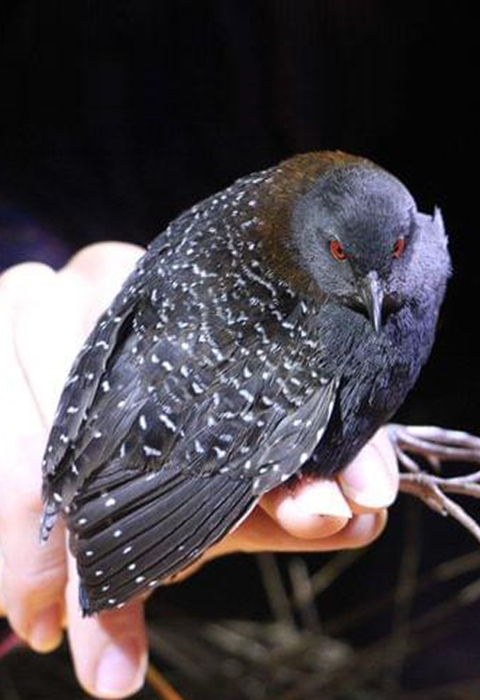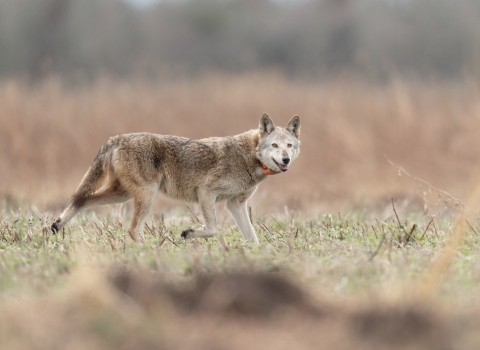The U.S. Fish and Wildlife Service and its partners are working to protect a small, secretive marsh bird that is in steep decline. Some populations of the eastern black rail along the Atlantic coast have dropped by as much as 90 percent, and with a relatively small total population remaining across the eastern United States, the Service is proposing to list the subspecies as threatened under the Endangered Species Act (ESA).
After a review of the best available scientific and commercial information, the Service determined the eastern black rail meets the definition of threatened because it is likely to become endangered in the foreseeable future throughout all or a significant portion of its range. A peer-reviewed species status assessment, produced by the Service, provides a biological risk assessment using the best available information on threats to the subspecies and evaluates its current condition. It also forecasts the eastern black rail’s biological status under varying future conditions.
Partially migratory, the eastern black rail is known to appear in as many as 36 states plus multiple territories and countries in the Caribbean and Central and South America. One of four subspecies of black rail, the eastern black rail, though rare, is broadly distributed but highly localized, and lives in salt, brackish, and freshwater marshes.
The California black rail subspecies -- confined to central and southern California, western Arizona and Mexico -- is not included in this listing proposal. Two other subspecies of black rail that occur in South America are also not included in this listing proposal.
In April 2010, the Service was petitioned to list the eastern black rail under the ESA. In September 2011, the Service published a 90-day finding indicating listing may be warranted. A settlement agreement in 2013 required the Service to complete a review of the subspecies and submit a 12-month finding to the Federal Register by Sept. 30, 2018.
Population size and trend estimates from a 2016 independent assessment of the subspecies indicated declining populations of eastern black rail. Estimates for the Atlantic Coast, ranging from New Jersey south to the Gulf Coast of Florida, are between just 355-815 breeding pairs. Estimates from a Texas research project indicated a population of around 1,300 individuals for the upper Texas Coast – a noted stronghold for the bird prior to Hurricane Harvey in 2017. No true population estimates exist for interior states such as Colorado, Kansas or Oklahoma, but there are small populations in Colorado and Kansas where the bird breeds in the spring and summer. With a lack of consistent monitoring and survey results for the Caribbean and Central America, there is no evidence to suggest that the eastern black rail is present in large numbers in this region, although it is likely the birds occur there.
Primary threats to the eastern black rail include habitat loss due to continued alteration and loss of wetland habitats, land management practices that result in fire suppression (or inappropriately timed fire application that may cause direct mortalities), grazing, haying and mowing, and impounding of wetlands.
In addition, projected sea level rise and associated tidal flooding, increased temperatures, decreased precipitation, increased drought and severe weather events producing flooding or changes in wildfire frequency and intensity are all likely to have significant impacts on eastern black rail populations and their habitat.
The Service is proposing a rule under the ESA’s Section 4(d) that would tailor protections for the bird. These protections include prohibiting certain activities in known eastern black rail habitat during critical time periods, such as nesting and brooding seasons, and post-breeding flightless molt periods. The Service is proposing certain prohibitions on the following activities during the identified critical time periods: approved fire management, haying, mowing, and other mechanical treatments, intensive grazing (only on public lands), and other forms of direct and incidental take outlined in the Federal Register notice. In addition, fire management activities not using best management practices to minimize impacts to the subspecies and its habitat are prohibited at all times.
To ensure public safety and meet operational needs for existing infrastructure, the proposed rule would also exempt mowing and mechanical treatment of rights-of-way, fire breaks and transmission corridors from the ESA’s “take” prohibitions.
The Service is not designating critical habitat for the eastern black rail at this time due to concerns that identifying such areas may attract birders seeking out these shy and elusive birds, placing additional stress on the subspecies. Through the public comment process, we are requesting information on the threats of taking or other human activity, including the impacts of birders to the eastern black rail and its habitat, and the extent to which critical habitat designation might increase those threats.
The Service will accept comments received or postmarked on or before December 10, 2018. Information on how to submit comments is available at www.regulations.gov by searching under docket number FWS–R4–ES–2018–0057.



